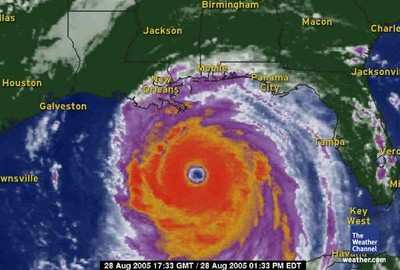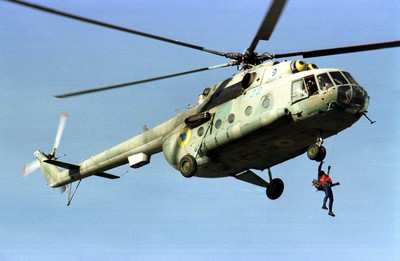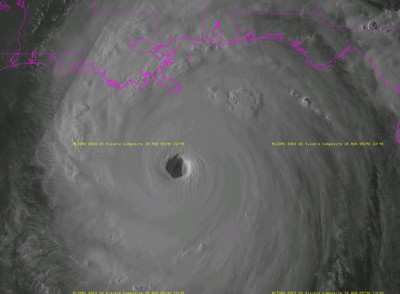Should Agency Bend Rules In Times Of Trouble?
As the 2006 hurricane season gets underway, we're still
processing the lessons from the 2005 hurricane season. And one of
those lessons might be found in the wake of Hurricane Katrina.

The Atlanta Journal-Constitution reports that the day the New
Orleans levees were breached last year, Chuck Hall -- President of
the Hospital Corporation of America's North Florida division --
moved to help out his colleagues at the Tulane hospital in New
Orleans.
There were 1,200 patients, staff and family members stuck there,
and Hall was faced with a tough question: where would he find the
airpower to get that many people out of New Orleans?
The answer appeared to be in Destin, FL... a Russian-made Mil-8
MTV helicopter. Larger than a UH-60 Black Hawk and just a tad
smaller than a CH-47 Chinook, the Mil-8 (below, right) can carry 26
people at a time... AND enough fuel to fly for upwards of four
hours.
Hall thought he had found his answer. After receiving permission
from the Mil-8's owner at Oregon's Vertol Systems Company, James
Montgomerie -- who then lined up a flight crew -- Hall placed a
call to the FAA for clearance to fly the helo. And that's when the
plan fell apart.

"First we had clearance, then all of a sudden it's grounded,"
said Ed Jones, an HCA vice president of supply chain operations.
Based in the corporation's Nashville headquarters, Jones was in
charge of securing helicopters for the rescue operation.
You see, the Mil-8 is certified under the Experimental category
-- as is the case with most ex-warbirds, foreign and domestic.
And the FAA is quite clear about its restrictions on Experimental
aircraft as far as where they can fly, and how many people can be
onboard.
"The big rub was certification versus air space," Jones
added.
But... given the nature of the devastation from Katrina, surely
an exception could be made, right?
Wrong. "These regulations exist for a reason," said FAA
spokesman Les Dorr. "You're talking about a helicopter that simply
was not certified to do that sort of flight into that sort of
terrain under those kinds of conditions."
The Mil-8 is already in use in 54 countries, where it serves
primarily as a transport aircraft, carrying troops and supplies. It
can also be used as a gunship.
 "I called the guy in
standards and said, 'It's a Russian Mi-8, for God's sake," Jones
said. "We got people dying on that parking garage. I need to have
this aircraft freed up. What do I need to do to get clearance on
this thing?"
"I called the guy in
standards and said, 'It's a Russian Mi-8, for God's sake," Jones
said. "We got people dying on that parking garage. I need to have
this aircraft freed up. What do I need to do to get clearance on
this thing?"
After a flurry of phone calls, Jones and Hall said the FAA
finally granted provisional acceptance to fly the Mil-8 for Katrina
evacuations... but then another inspector in Baton Rouge, LA threw
a wrench in the works once again, and warned the two not to think
of flying the helo until an FAA inspector could come out and give
the Russian helo the once-over.
Montgomerie says when he asked the inspector how soon he could
be there, the inspector told him "'well I'm kind of busy... I think
I can get there sometime in the next six weeks.'"
"I found the Washington bureau [of the FAA] very helpful in
trying to get the appropriate approval," Hall added. "I found the
folks in Baton Rouge to be somewhat of a challenge in getting the
final approval to fly."
Eventually, the FAA did grant a "national interest waiver" that
allowed the Mil-8 to be used in the Tulane rescue.... but by the
time they received permission, Jones and Hall said, all the people
at the hospital had already been evacuated.
"It never was able to fly a mission," Hall said.
There is some good news to report, however... Dorr reports that
since the incident, the FAA has come up with ways to streamline the
special-issuance process.

"We have had internal discussions about an operational response
plan and how we can help to get things done more quickly," he
said.
 NTSB Prelim: Piper PA-23
NTSB Prelim: Piper PA-23 ANN FAQ: Submit a News Story!
ANN FAQ: Submit a News Story! Classic Aero-TV: One Mans Vietnam
Classic Aero-TV: One Mans Vietnam ANN's Daily Aero-Linx (07.03.25)
ANN's Daily Aero-Linx (07.03.25) ANN's Daily Aero-Term (07.03.25): High Speed Taxiway
ANN's Daily Aero-Term (07.03.25): High Speed Taxiway






